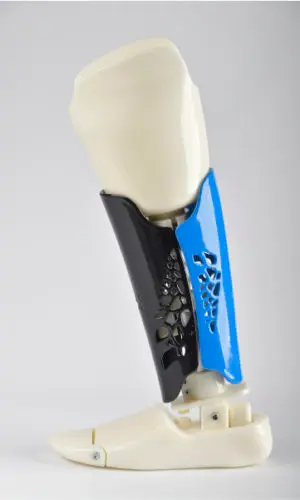ABS (Acrylnitril-Butadien-Styrol-Copolymerisat) ist ein hochwertiger, amorpher, thermoplastischer Kunststoff, der im professionellen 3D Druck am häufigsten eingesetzt wird. Das ABS Filament zeichnet sich durch seine Beständigkeit gegenüber Temperaturen bis 95 Grad, Ölen, Fetten und diversen Chemikalien aus.
Eigenschaften von ABS Filamenten
Das Datenblatt sowie das Sicherheitsdatenblatt, finden Sie unter folgenden Links:
- ABS Filament Datenblatt
- Filament Sicherheitsdatenblätter gesamt
Auszug aus dem ABS-Datenblatt:
| HDT – Temperaturbeständigkeit | 95°C |
| Dichte: | 1,08g/cm³ |
| Lagerung | Bei Raumtemperatur, geschützt vor direktem Sonnenlicht und Feuchtigkeit |

Druckparameter für ABS Filament
Die Verarbeitungsparameter können je nach 3D Druckermodell und Bauteil abweichen. Unter folgenden Links können Sie unsere Simplify3D Profile für ABS herunterladen:
ABS Druckparameter:
| Extrusionstemperatur: | 220 – 240 °C |
| Druckbetttemperatur: | 88 °C (1.Schicht)100 °C (ab 2.Schicht) |
| Druckoberfläche: | Kapton |
| Aktivkohlefilter: | Erforderlich |
| Innenraumheizung: | >50°C |
Nachbearbeitung von ABS
Folgende Nachbearbeitungsmethoden können bei ABS verwendet werden:
- Schleifen
- Füllern
- Lackieren
- Kleben mit Aceton, 2-Komponentenkleber oder Sekundenkleber
- Fräßen
Downloads
- ABS Filament Datenblatt
- Filament Sicherheitsdatenblätter gesamt
- EL-102 FFF Dateien
- EL-11 FFF Dateien
Fragen und Antworten zum ABS Filament:
ABS Kunststoff ist der am häufigsten eingesetzte Kunststoff als Filament für den professionellen 3D Druck.
- ABS braucht eine Extruder- bzw. Düsentemperatur von 220°C-240°C,
- eine Heizbetttemperatur von mindestens 80°C
- eine beheizte Kammer mit mindestens 70°C
Wichtig ist, dass Sie folgende Punkte beachten:
- Heizbett auf mindestens 80°C einstellen
- Erste Schicht mit 50% Geschwindigkeit fahren
- Angeraute, gereinigte und passende Druckoberfläche verwenden
ABS ist nur bedingt UV-Beständig und kann durch Sonneneinstrahlung brüchig werden. Für Außenanwendungen empfehlen wir unser UV-beständiges ASA Filament.
